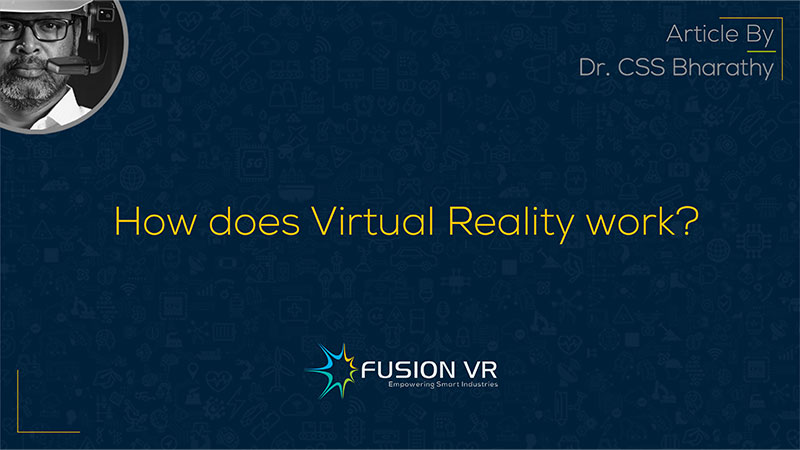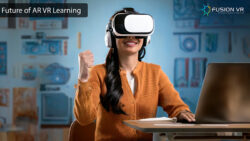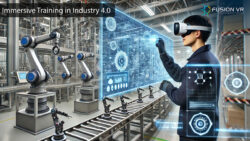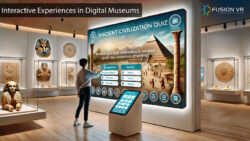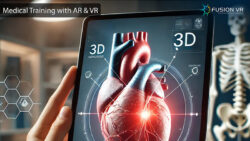Virtual Reality is emerging as one of the most transformative technologies of the 21st century. The future of the metaverse is also tied to this exciting technology. From its early adoption by the gaming community, virtual reality has not just come a long way but promises an exciting future as well. The technology has proven to have a diverse set of use cases across many areas of human activity. It is also one of the most important technologies driving the Fourth Industrial Revolution, which is popularly referred to as Industry 4.0. The world is racing to develop a tremendous number of VR applications to fulfil our needs and wants. With so much in store, it behoves all of us to learn and understand more about this technology and how humankind can benefit from it.
So the first question would be, what is virtual reality, and how does it work? Virtual reality requires the use of a headset that completely covers your eyes and immerses you in a simulated computer generated three-dimensional space. As you are being cut off from the true reality surrounding you, something magical begins to happen. Your brain begins to believe and simultaneously makes you feel that you are in the 3D virtual environment that you are now seeing. The environment that you see changes in the directions that you see and move. You are given hand controllers that enable you to pick stuff and also navigate in this virtual reality that you find yourself in. You begin to lose a sense of the outside world and are completely immersed in this digital world. The only thing that you need to be mindful of is that you cannot move freely in the real physical space surrounding you as your vision of that space is blocked, and you could possibly hurt yourself.
The headset you are wearing could be standalone or tethered. The wired connection would be to a computer which has a greater processing capacity than what is available on a standalone headset. This is, of course, dependent on the experience that you are looking for. The more complex the experience, the need for greater processing and robust computer systems becomes necessary. I hope this gives you a conceptual understanding of what virtual reality is. There’s extensive information in knowledge hubs across the internet which can whet your desire to learn more about virtual reality.
The next obvious question would be, what is a virtual reality headset, and how does it work? The VR headset is like a pair of goggles that completely covers your field of view. Inside the headset, you would find electronic and optical components. The optical hardware is a pair of lenses through which you are able to see the simulated environment on a split LCD panel positioned in front of it. The lenses and the split panel provide the stereoscopic visual experience that you are accustomed to in real life. In other words, it just mimics the way we see the things around us. It is as simple as that! There is a motherboard that has the circuitry that connects all the components in the headset. In addition to that there is something called as Inertial Measurement Unit sensors that track your head movement in all directions. This unit has gyroscopes, accelerometers and magnetometers that measure orientation, speed and direction of your head movement in the virtual space. This is also referred to as three degrees of freedom in VR lingo. This head tracking is fundamental to the VR experience once you wear the headset and enjoy the realism of a simulated environment. To experience 6 degrees of freedom, these headsets need to have computer vision sensors as well. In addition to these you would have hand controllers that allow you to interact and navigate in the virtual world.
Embracing the Exciting Technology of Virtual Reality
So, how is virtual reality content created for us to experience and enjoy? Broadly speaking, its done in two ways. The first is where the entire environment is digitally created and programmed to provide a simulated experience. The other way is to create a video using an omnidirectional camera which is then expertly edited to create an immersive experience of being in that natural environment. Both modes of VR content creation have their unique uses. To experience a place or event that may be hard to go to or expensive to visit, we can use VR to give us the experience of actually being there. Take for example, visiting the Taj Mahal or the Dal Lake in Kashmir. VR has made it possible for everyone to experience it from the comfort and safety of their home or office. VR can also create environments that are futuristic, complex or just dangerous to get there. More than just a medium to experience something, VR helps to create environments that enable people to learn, train and demonstrate competencies that they can quite easily translate in the real world.
What is then the future of virtual reality? Where do we go from here? The growth of virtual reality has been tremendous. The technology is maturing quite quickly and the cost of devices is coming down due to increasing adoption of VR in the industry and for personal use. Statista reports that more than 6 million headsets were sold in 2021. Analysts predict that the VR market is projected to grow from $16 billion this year to nearly $230 billion in 2029. It is quite clear that there are massive opportunities for all with this technology.
There is a great demand for VR and AR engineers which is estimated at 1400% and is expected to grow at 280% each year. The metaverse and its opportunities are also fueling the growth of the VR industry. Everyone wants to be part of the metaverse and reap the benefits that are being projected. This presents a great opportunity for youngsters in India and across the world. In India, many prominent VR companies are gearing up to support companies and educational institutions with services aimed at supporting their business and vr training needs. They understand the skills gap we see currently and are prepared to close that gap with innovative industry-academia partnerships.
I hope that I have given you a flavor of what virtual reality, how it works and where we are heading. As a VR evangelist, I have participated in several seminars and delivered keynote speeches. I have sensed the energy and hunger to tap into this exciting technology by all the participants. I truly believe that you will begin exploring more about VR and make a significant difference in the area that you are currently working in. Please visit the Fusion VR website to learn about this and other futuristic technologies and how we can partner with you to change the future of this country.

